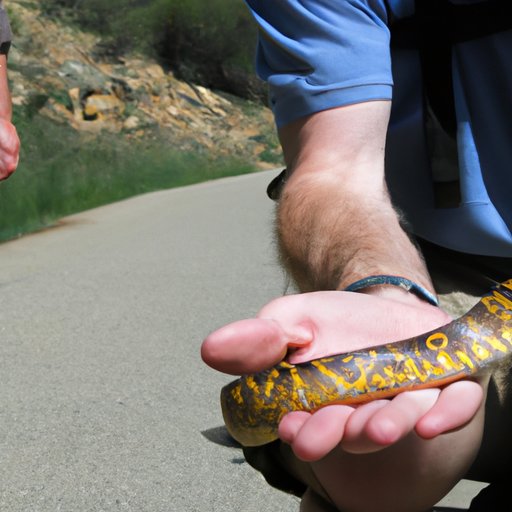Introduction
Rattlesnakes are some of the most feared creatures in the outdoors. These venomous snakes can be found throughout the United States and while they rarely attack people, their bites can be deadly if not treated promptly. Knowing what to do if you are bitten by a rattlesnake while hiking is essential for staying safe in the outdoors.
Overview of Rattlesnake Bites
Rattlesnakes are members of the pit viper family and are found in many parts of the United States. They have a distinct rattle at the end of their tail that they use to warn potential predators. While rattlesnakes typically avoid humans and will only bite as a last resort, a bite from one of these venomous snakes can be serious and even deadly if not treated immediately.

Know the Signs of a Rattlesnake Bite
If you think you’ve been bitten by a rattlesnake, it’s important to take action quickly. The first step is to identify the bite. Rattlesnake bites usually occur on the legs or arms, but can happen anywhere on the body. The bite may produce two puncture wounds where the snake’s fangs entered the skin. There may also be swelling, redness, and pain around the area.
Seek Immediate Medical Attention
If you’ve been bitten by a rattlesnake, it’s important to seek medical attention as soon as possible. Rattlesnake venom can cause tissue damage, organ failure, and even death if left untreated. It’s best to call 911 or go to the nearest emergency room for treatment.
Apply First Aid Techniques
While seeking medical attention should be your top priority, there are some steps you can take to help reduce the effects of the venom. Wash the wound with soap and water to help reduce the risk of infection. Apply a bandage to the wound and keep the affected area immobile. Finally, keeping the bitten area lower than the heart can help slow the spread of the venom.
Remain Calm and Keep the Affected Area Immobile
In addition to seeking medical attention and applying first aid techniques, it’s important to remain calm and keep the affected area still. Moving the affected area can cause the venom to spread more quickly. Try to stay as still as possible until you can get to the hospital.

Educate Yourself About Rattlesnake Bites and Prevention
Once you’ve been treated for a rattlesnake bite, it’s important to educate yourself about rattlesnakes and how to prevent future bites. Learn about the different types of rattlesnakes in your area and take precautions when you are outdoors. Wear long pants and sturdy shoes when hiking and be aware of your surroundings. If you are bitten, seek medical attention right away.
Conclusion
A rattlesnake bite can be a scary experience, but knowing what to do can help reduce the risk of serious injury or death. If you are ever bitten by a rattlesnake, remain calm and seek immediate medical attention. Apply first aid techniques such as washing the wound and keeping the affected area immobile and lower than the heart. Educate yourself about rattlesnakes and prevention to help reduce the chances of getting bitten again.


